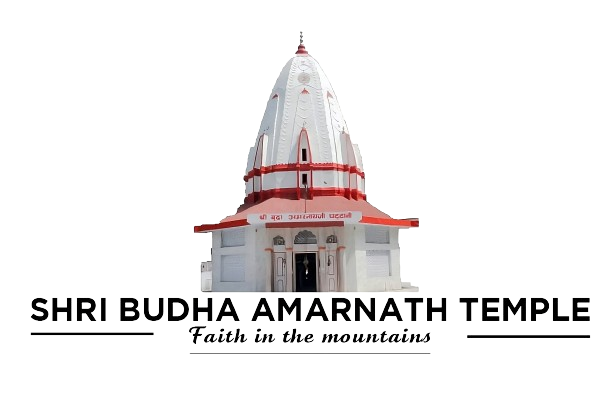Swami Budha Amarnath Ji Mandir is situated in between the main belt of Pir Panchal Range at Rajpura Mandi which is 25 kms on the North East of Poonch city. This sacred place is located on the confluence of two gushing streams namely Nallah Gagri and Pulsta river. This place is surrounded by snow bounded lofty peaks, thick belt of fur forests (in the Eastern side), lush green pastures and crystal clear streams. The climate of this attractive and charming spot is very pleasant and cool. The original mandir has been constructed out of with one big stone. There are four doors in the Mandir on the northern, southern, eastern and western sides which indicates that the doors of this shrine are open for all the four varnas. There is a natural Shivlinga of white stone (chakmak) inside the mandir. Number of ancient idols collected there from nearby villages are also installed in the premises of the mandir where were four holy springs near the mandir in the past.At present the water of three springs has been diverted to fourth one which is on the southern side of the mandir. The water of these springs is considered holy from religious point of view. The pilgrims first take bath in this spring and then enter in the mandir for prayers.The main religious function held on the occasion of Raksha Bandhan which is known as MELA SWAMI BUDHA AMARNATH JI FESTIVAL.Three days before the mela, a religious congregation is held at Dashnami Akhara Poonch for performing Havan and Pooja of Chhari Mubarak. In this congregation people from all walks of life come and pay tributes to the sacred mace after bhajan, kirtan and prevachans (speech) of the Mahant of the Akhara. The procession of Chhari Mubarak starts from Akhara.A guard is offered to Chhari Mubarak at the gate of the Akhara. The Mahant Ji is being carried in a palki by the devotees alongwith the sacred mace. Thousands of devotees and Sadhus accompany the procession which leads towards Swami Budha Amarnath Ji mandir at Mandi on foot. The first and main halt is at Chandak. While on way from Poonch to Mandi, a number of stalls are being erected for welcoming the Chhari Mubarak and yatries and free langer and other eatable items are provided to them.The stalls are being managed by muslims also and they welcome the yatries and Chhari Mubarak by providing them refreshment enroute Poonch to Mandi. The procession reaches at Rajpura on the same day in the afternoon where it is received by the district administration , local people, sadhus and workers of the trust after guard of honour by the BSF contingents at the gate of Swami Budha Amarnath Ji mandir and the chhari Mubarak is taken to the main shrine in between the traditional rituals followed by the Aarti of Lord Shiva.A number of legends are famous in and around Poonch city regarding the eruption of this ancient temple. As per one legend, Mahatma Pulsta (the grandfather of King Ravana of Sri Lanka) meditated at this very place for a pretty long time. He was a devotee of Lord Shiva. There are a number of references in Neelmat Puran about Pulsat Rishi. As per these references, Pulsat was also an artist and sculptor. He erected a number of images of God. One of the reference in Neelmat Puran is as under:-‘By seeing the Goddess erected by Pulsat, one is free from all his sins and gets highest knowledge……. The temple erected by him gives one’s merit of the gift of cows and also releases from the diseases’.The legend goes that Pulsat meditated with such a devotion at Rajpura Mandi that Lord Shiva gave him Darshan at this very place. In the memory of Darshana of Lord Shiva, Rishi Pulsat constructed the temple of Shiva and erected a lingum there. Since the Pulsat was a great Rishi, a sculptor and very popular among the habitants of this area, therefore, after his death the people converted this small temple into a shrine.
